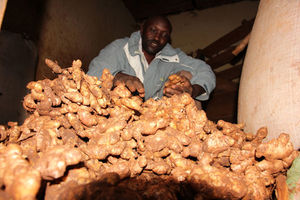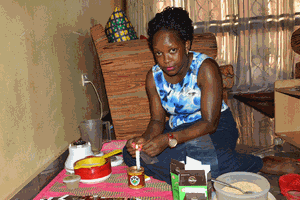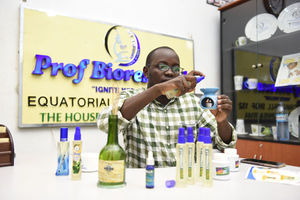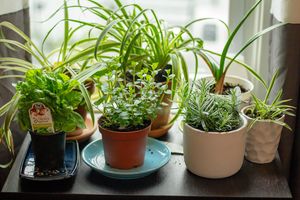
Ms Irene Nansubuga on her herbs farm. Photo/Shabibah Nakirigya
We have varieties of natural herbs which are consumed by human beings some of them are medicinal and others are used as spices in drinks and food.
Ms Irene Nansubuga the executive director of Nancy herbs and wellness, says that the idea of growing natural herbs started with a passion she has on gardening and greening at home.
“When I was still in school I used to grow food crops before going back to school and by the time we break off for holidays it was ready for harvest,” she says.
Ms Nansubuga adds that when she grew up the idea of owning a backyard garden did not decline, it instead expanded.
How she started
She says the idea of growing herbs started when her son fell sick, suffering from convulsion, she decided to google for natural remedy to treat seizures and landed on an article which indicated sage as an herbal medicine.
“I started looking for sage in the nearby markets until I landed on it around Mukwano. I got a seedling and planted it at home,” she says.
Ms Nansubuga adds that while doing research on internet about sage she landed on other herbs and that’s when she resorted to make it a business.
“Since then I started doing research about different herbs and taught myself about the preservation and propagation if am to make it a business.”
“Sage is the largest on my farm. I now grow more than 10 herbs and spices,” says Ms Nansubuga.
The less than one-acre piece also has chamomile, rosemary, tarragon, oregano, lemon grass, basil, chives, aloe vera, thyme and other herbs.
Business in herbs
Ms Nansubuga started the venture in 2020 when growing herbs was gaining popularity in Uganda. She had been informed that herbs have nutrients and compounds with significant health benefits.
That prompted her to embark on market research. She concluded that growing rare herbs would be profitable.
To bolster her skills and knowledge, Ms Nansubuga consulted several crop scientists on organic farming.
The experts including Julius Nyanzi of Prof Bioresearch gave her information on how to set up an organic farm by incorporating agroforestry, vermiculture and other systems.
“After having a lot of seedlings in stock I started posting them on social media and people started making orders on line and that’s how the business expanded,” she says.
Ms Nansubuga says that because of the limited space she embraced the Western method of farming, using the garden boxes for different varieties.
“Some people prefer fresh herbs, others dry leaves. The seedlings are at Shs5000 each when you want to grow them at your home,” she says.
On-farm processes
Ms Nansubuga’s day ordinarily begins with a working plan that involves taking her employees through their duties. She then monitors and evaluates their work.
“The first step in sage cultivation is land preparation. Manure is incorporated into the soil to improve structure and moisture content,” the herb grower tells Seeds of Gold.
Seeds are sourced from credible and certified propagators. After planting, organic fertiliser and foliar spray are applied to help in vegetative growth and root development.
“We water the land before planting. This moistens the soil in the first few weeks of establishment,” Ms Nansubuga says, adding that preventive spray is also administered after every two weeks. The first harvest of sage is three to four months after planting. This goes on every month or month and a half for three years, depending on the management practices. It is cut between 15 to 18 centimetres to the shoot. Ms Nansubuga gets about 100 kilogrammes of sage in one season.
Long droughts
After harvesting, the sage is graded, bunched and weighted, depending on a customer’s specifications.
Most of Ms Nansubuga’s customers prefer raw sage that goes for Shs10,000 per kilogramme.
The price usually depends on quality. Most of the buyers are within Kampala.
Challenges
“Growing herbs has many challenges. Unskilled workers are not really reliable so I must be around most of the time,” she says.
The other challenges are the long droughts and getting the right technical advice. She has learnt many lessons, key among them being sage herbs are easy to grow and manage.
“One can start small and scale up production with time,” she says.
And she has a five-year dream. Ms Nansubuga hopes to diversify from just drying herbs to value addition. She hopes to begin making sage oil and packaging dried herbs.
Sage as medicinal herb
Ms Nansubuga says that sage is medicinal herb which is perennial and when you grow it, it does not change the appearance.
“When you need to propagate more, you have to cut and it grows again. The stem can produce more buds whenever they are cut,” she says.




